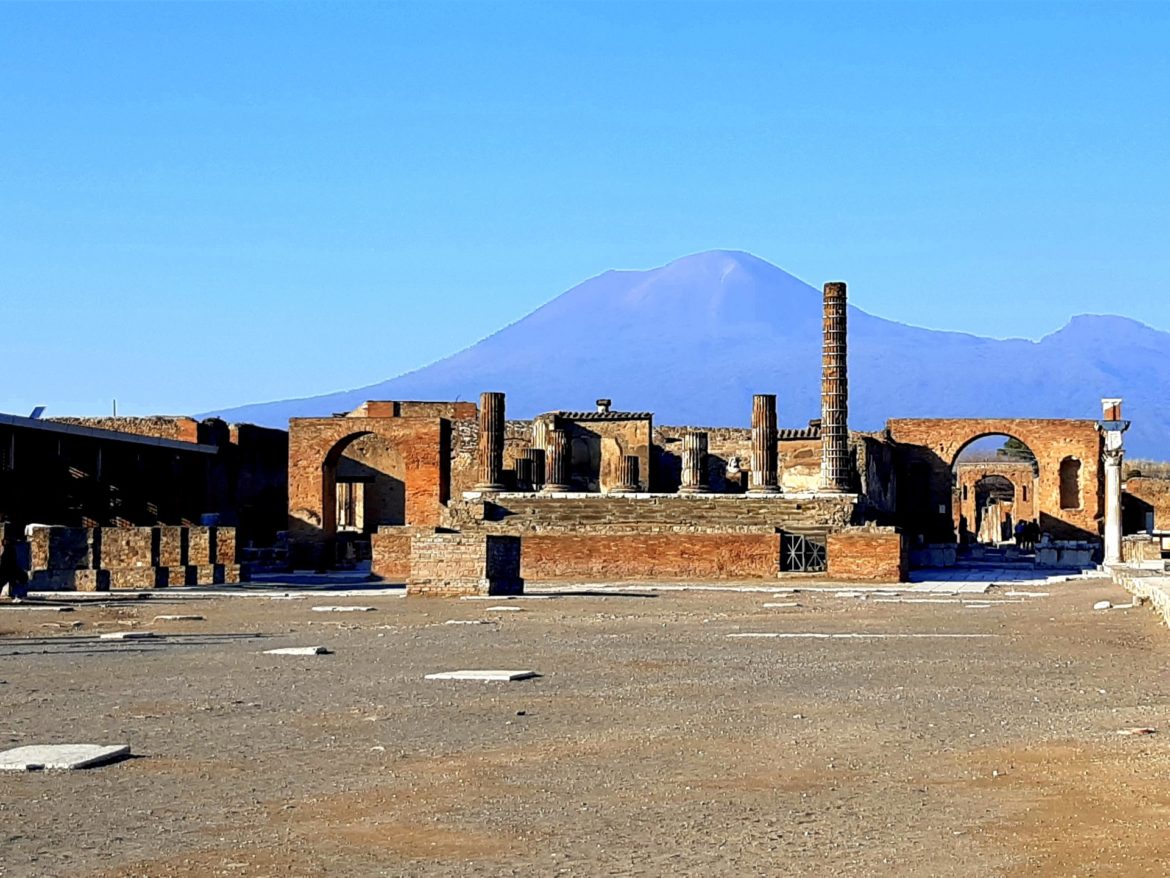Visiting Pompeii takes you back in time to 79 AD, when Mount Vesuvius erupted, burying Pompeii in ash and petrifying all life. Today, you not only learn about history and how people lived. Visitors discover one of the greatest archeological sites of all times. Planning is essential to fully enjoy it here. Being there numerous times, here’s my Pompeii top 10 attractions.
Background of Pompeii
On August 24, 79 AD Mount Vesuvius erupted spewing ash and poisonous gases for 18 hours. Nearby Pompeii became buried under 30 feet of ash and pumice and almost everyone instantly died. Pompeii remained buried for about 1700 years, when the excavations began in 1748. Overall, about 75% of Pompeii’s 165 acres were excavated. It’s estimated that most of the 20,000 people from both Pompeii and Herculaneum fled when the volcano first began rumbling. Most of the 2,000 that stayed, immediately perished. About 1,000 bodies were recovered and some were later preserved in plaster casts, that you can see at the archeological site.
An interesting fact is that the direction of the wind could have changed the outcome for the better at Pompeii. When Vesuvius erupted, the wind was blowing northwesterly toward Pompeii. Usually, the wind would have blown southwest instead, which would have saved and blown everything away from Pompeii.
Train to Pompeii: In southern Italy, just 15 m (24 km) from Naples, Pompeii is easily accessible by train. The Circumvesuviana Train goes from Naples and Sorrento to Pompeii Scavi. From Rome also there are day tours to Pompeii.
Pompeii Top 10 Attractions
The Forum: This was the oblong-shaped main square of Pompeii. It was the center for attracting crowds in the open space. It’s enclosed by colonnades and surrounded by buildings, temples, porticos and a basilica. The Temple of Jupiter is raised on a base north of the main square.
Brothel: Called the Lupanar, this was the main brothel in Pompeii. (Excavations conveyed 35 brothels in Pompeii.) The Lupanar had 12 cells, many of them with stone beds still there. Also, left behind are the colorful and graphic frescoes. You can actually sit and do a fun photo op on the stone beds.
Villa of Mysteries: This villa is famous for its gorgeous frescos in one room. The show the initiation of a young woman into a Greco-Roman mystery cult. Overall, the 7 fresco series with a red background are the following scenes: Reading of Rituals, Silenus playing Lyre, Satyr and Nymph, Silenus offering wine to Satyr, Bacchic rite, Cupid holding up mirror and lastly, Initiate on a throne.
Sanctuary of Apollo: This was one of the most important temples of Pompeii in the central Forum. Apollo was the Roman God of the sun and light, music, poetry, healing, archery and agriculture Many of the 48 Ionic columns still remain, with the replica bronzed statue of Apollo.
Western Houses included the largest home called House of Faun
Western Houses: Near Porta Ercolano, the neighborhood included the House of Faun, House of the Tragic Poet and House of the Silver Wedding. Furthermore, the House of Faun was the largest (square block) and most expensive residence in ancient Pompeii. It’s named after the bronzed statue of a dancing faun in the atrium’s reflecting pool. Also, the statue on site is a replica of the original in the Archeological Museum of Naples.
In addition, the House of Faun had spectacular floor mosaics, that are now in the Naples Archeological Museum. However, I was there in 2013 before they took them to the museum, as shown in my photos. For example, my favorite is the 2 doves pulling a necklace out of a bag.
Temple of Isis: This temple is dedicated to the Egyptian Goddess, who was a popular Roman Empire cult. It’s still relatively intact and one of the first temples discovered in excavation. Also, most of the paintings and sculptures are now exhibited in the Archeological Museum of Naples.
Garden of the Fugitives has highest number of victims with 13 found in one place.
Plaster Body Molds: Those that didn’t flee Pompeii became buried for 1,700 years under 30 feet of ash and mud. During excavations, they noticed air bubbles around the human remains. So, they poured plaster of paris in the void. This molded the final poses and faces of those bodies recovered and even a dog.
The street with the most bodies is called the “alley of skeletons.” It’s both intriguing and eerie to observe these molded figures and realize the grim reality of their last moments of life.
Stabian Baths: These baths separated the men and women sections. Along with dressing rooms, these included 3 temperature variations: Frigidarium (cold baths), tepidarium (warm baths) and calidarium (hot baths).
Pompeii’s Amphitheater is the oldest one built in stone around 70 BC.
Amphitheater: This large venue with a capacity for 12,000 spectators cheered to gladiators and games. The preservation of Pompeii’s amphitheater provided insights on the gladiatorial culture of ancient Rome. Also, a fun fact is that Pink Floyd performed here in 1972.
Antiquarium: Originally built in 1873, this museum is just a 3-minute walk from the archeological site. Later, the Antiquarium underwent an official inauguration for reopening its new layout in 2021. After getting the big picture from the archeological site, it’s nice to learn the details at the museum. So, don’t overlook this to uncover even more archeological insights.
Overall, Pompeii Top Attractions
It is such a wonderful opportunity to explore this amazing archeological site. There’s so much to learn about history, volcanoes and archeology from Pompeii. Also, the nearby Herculaneum is just as fascinating for different reasons. So, if you have time, catch it as well. And to think, if the wind blew another direction on that monumental day, Pompeii may still be here alive and well. It’s intriguing to ponder this possibility.
Read More!
Picturesque Taormina, Sicily Walking Tour Highlights
Rome’s (“The Eternal City”) Top 10 Historic Highlights Tour
Magnificent Florence “Firenze,” Italy’s Top 12 Attractions










